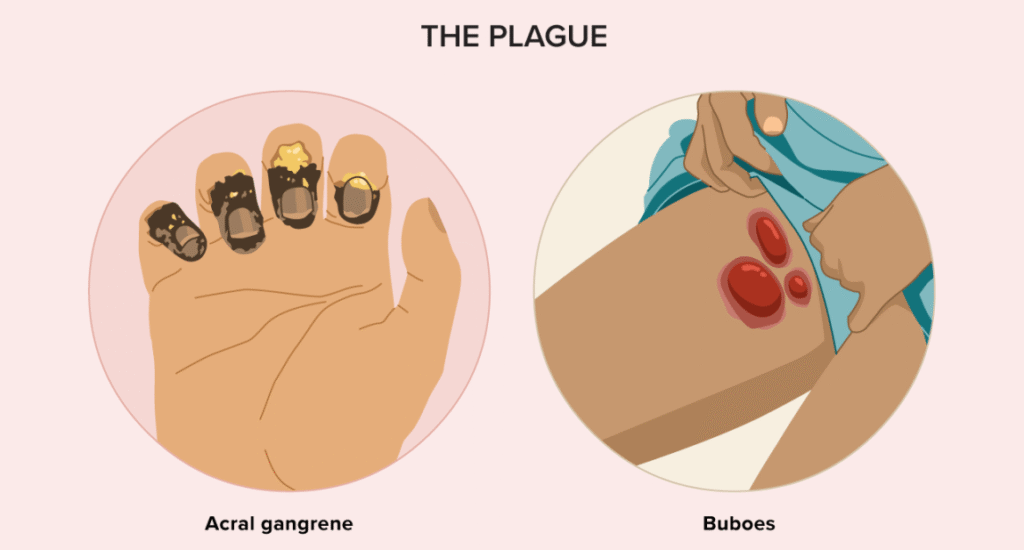The Bubonic Plague, often referred to as the Black Death, is one of the deadliest diseases in human history. Though most commonly associated with the medieval pandemic that killed millions across Europe and Asia, this plague is not just a thing of the past.
In this blog, we’ll explore:
- What causes the bubonic plague
- How it spreads
- Its symptoms
- Historical impact
- Whether it’s still a concern today
Let’s break it down step by step.

🧬 What Causes the Bubonic Plague?
The bubonic plague is caused by a bacterium called Yersinia pestis. This bacterium is typically found in rodents like rats and rabbits, and it spreads to humans through the bites of infected fleas.
In some cases, it can also be transmitted by handling infected animals or inhaling respiratory droplets from someone with pneumonic plague, a more severe form of the infection.
🦟 How the Bubonic Plague Spreads
Here are the most common ways the plague spreads:
- Flea Bites: Fleas feed on infected rodents and pass the bacteria to humans.
- Direct Contact: Touching infected animals or contaminated materials.
- Respiratory Droplets: In the case of pneumonic plague, coughing can spread the bacteria to others.
This makes the disease zoonotic, meaning it can jump from animals to humans.
😷 Symptoms of Bubonic Plague
Symptoms usually begin within 2 to 6 days after exposure. The classic signs of bubonic plague include:
- High fever and chills
- Sudden onset of weakness
- Painful, swollen lymph nodes (called “buboes”)—commonly found in the neck, armpit, or groin
- Headaches
- Muscle aches
If not treated quickly, the infection can evolve into:
- Septicemic plague (spread through the blood)
- Pneumonic plague (affecting the lungs, can spread through the air)
🕰️ History of the Bubonic Plague – The Black Death
The most devastating outbreak of the plague occurred in the 14th century, known as the Black Death. Originating in Central Asia, the disease traveled via trade routes and ships to Europe, where it wiped out nearly a third of the population—somewhere between 75 to 200 million people.
The plague didn’t just kill—it transformed societies. Labor shortages led to economic shifts, weakened feudal systems, and sparked new approaches to public health and medicine.
Key Timeline:
- 1346–1353: Peak of the Black Death in Europe
- Spread by trade ships via the Silk Road and Mediterranean ports
- Major outbreaks also occurred in Asia, North Africa, and the Middle East
🧪 Is the Bubonic Plague Still Around?
Yes, the bubonic plague still exists today—but it’s rare and highly treatable with antibiotics.
According to the World Health Organization, plague cases are reported every year in:
- Madagascar
- Democratic Republic of Congo
- Peru
- Some rural areas of the United States, particularly in the Southwest
Thanks to modern medicine, outbreaks are small, and death rates are very low if treated early.
💉 Can It Be Prevented or Treated?
Absolutely. Prevention and early treatment are key.
How to prevent plague infection:
- Avoid contact with wild rodents and their fleas
- Keep pets flea-free, especially in plague-prone regions
- Don’t handle sick or dead animals without protection
Treatment:
- The plague can be treated with common antibiotics like streptomycin, doxycycline, or gentamicin
- Early diagnosis is crucial—delays can be fatal
🙋 Frequently Asked Questions (FAQs)
Q1. What’s the difference between bubonic, septicemic, and pneumonic plague?
- Bubonic plague affects the lymph nodes (most common).
- Septicemic plague infects the bloodstream (more severe).
- Pneumonic plague affects the lungs and can spread between people.
Q2. How many people died from the Black Death?
Estimates vary, but it’s believed between 75 to 200 million people died during the 14th-century pandemic.
Q3. Is the plague contagious?
Yes—especially the pneumonic form, which can spread through coughs or sneezes. Bubonic plague spreads mostly through fleas and contact with infected animals.
Q4. Can I still get the bubonic plague today?
Yes, but it’s rare. There are about 100–200 cases per year worldwide, and most are treatable with antibiotics.
Q5. What’s the survival rate today?
With proper treatment, the survival rate is over 85–90%. Untreated cases can be fatal.
